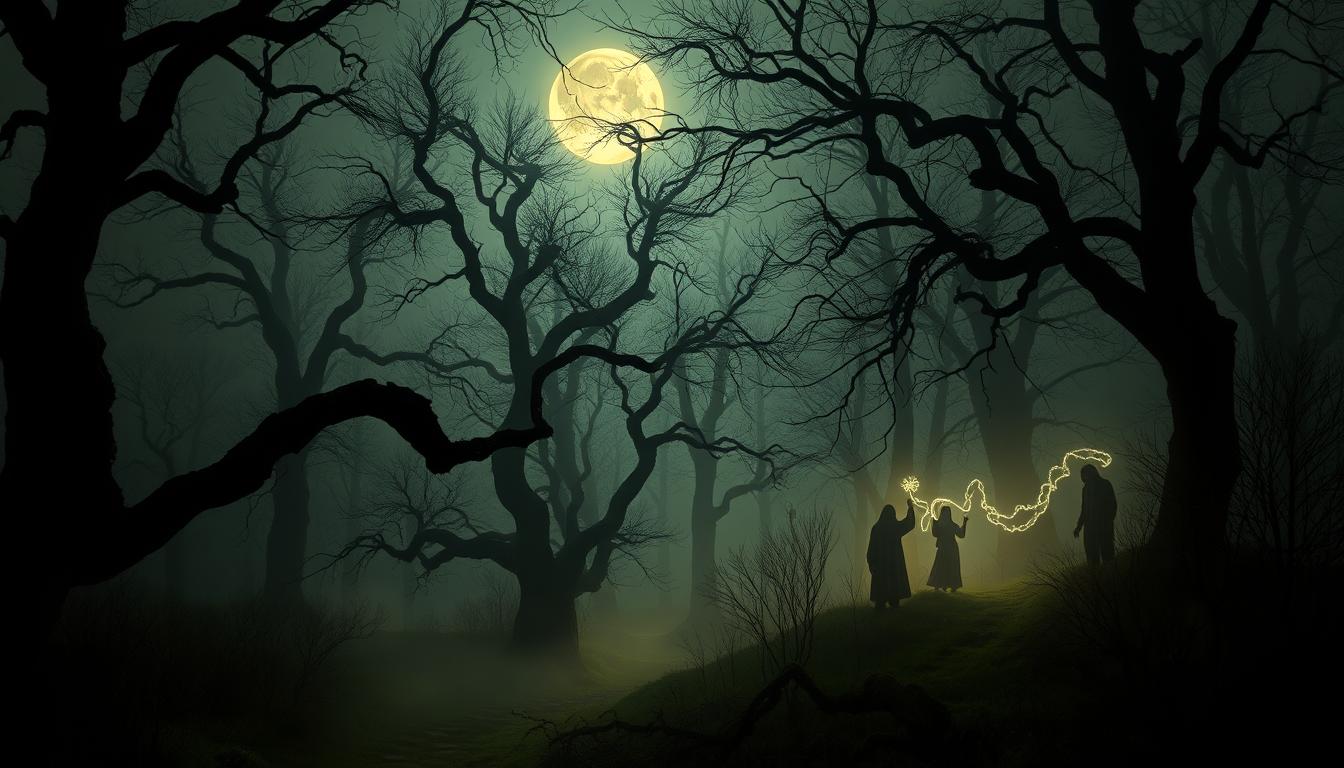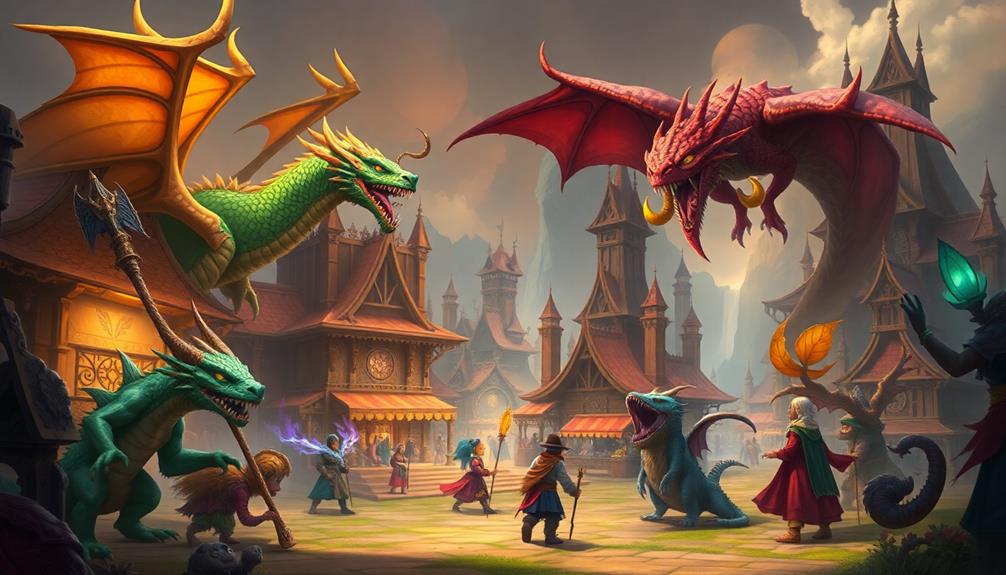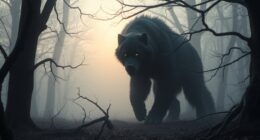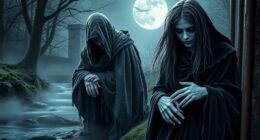Have you ever felt a shiver run down your spine at the mention of ghostly sightings or experienced a sudden chill in a room where no window was open? You are not alone. The fascination with the supernatural weaves through the fabric of our lives, stirring curiosity and, often, a profound sense of wonder. As children, many of us reveled in ghost stories told around campfires, the kind that made our hearts race and ignited our imaginations. Yet, these aren’t merely tales for Halloween; they remind us of deeper connections to a world beyond our understanding. This article invites you to embark on a spine-tingling journey through time and space, exploring documented encounters, haunted locations, and the emotional narratives of those who have brushed against the ethereal. Together, we will unveil the layers of intrigue surrounding these paranormal encounters, revealing not just the stories, but also the profound impact they have on our collective psyche. So, let’s turn the page into the world of the uncanny, where the past meets the present, and the supernatural phenomena of yesterday resonate in today’s experiences.
Key Takeaways
- Ghostly sightings captivate people across cultures and histories.
- These encounters often evoke deep emotional and psychological responses.
- Historical contexts enrich our understanding of modern ghost stories.
- Haunted locations tell stories beyond mere entertainment; they hold historical significance.
- Personal experiences with the paranormal vary widely, adding to the intrigue.
The Fascination with Ghostly Sightings
The intrigue surrounding ghostly sightings has captivated people’s minds for centuries. The fascination with ghosts is evident in various cultures, highlighting a universal interest in the supernatural. Approximately 41% of U.S. adults express beliefs in spirits, underscoring this enduring appeal. Many stories arise from personal experiences and cultural narratives that provoke curiosity about life beyond death.
Environmental factors such as dim lighting or atmospheric conditions can significantly influence one’s perception of ghostly events. A well-known fact is that psychological elements contribute to why individuals report encounters with ethereal beings. The experience of sleep paralysis can lead to distorted perceptions, prompting some to label these occurrences as ghostly sightings. Reports from Dr. Chris French’s research reveal that hallucinations, though common, occur in a small percentage, linking them to the substantial belief in spirits.
The narratives surrounding ghostly sightings suggest a yearning for connection with something greater than the physical world. While scientific explanations include electromagnetic fields and infrasound waves, the paranormal interests remain deeply rooted in our collective consciousness. Organizations such as A Night Among Ghosts provide avenues to investigate these phenomena, emphasizing genuine inquiries while acknowledging the often elusive nature of the paranormal.
Data collected from various locations has shown interesting correlations. Dr. Shane Rogers highlights a statistical relationship between mould presence in certain homes and reports of hauntings, further feeding into the complex dialogue about what we perceive as the supernatural. The fear of mortality plays a role in the beliefs in spirits, revealing a human desire to seek reassurance about existence beyond death. This mix of personal narrative, historical context, and scientific exploration continually enriches the allure of ghostly sightings.
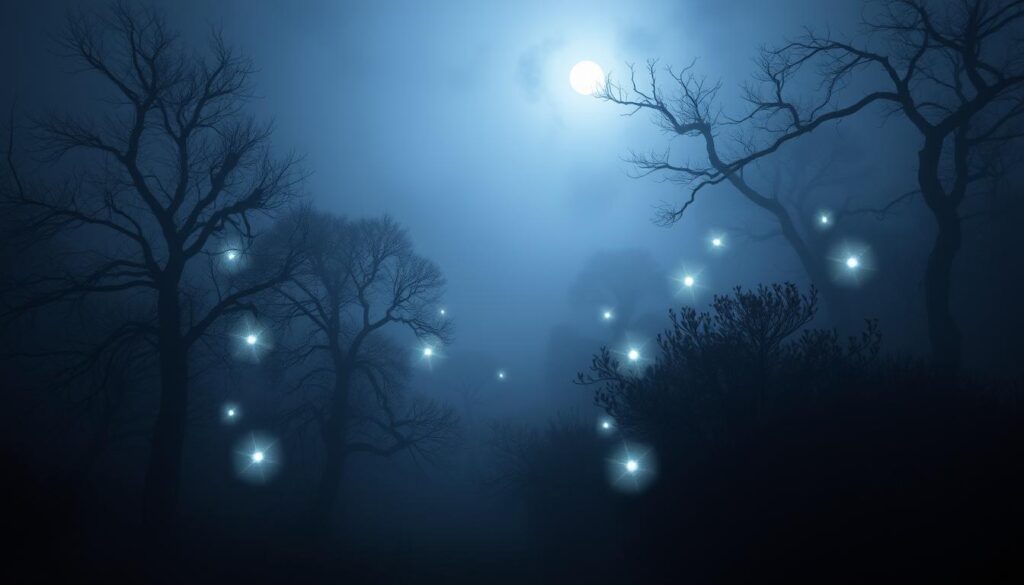
Understanding Ghosts and Spirits
To grasp the concept of ghosts, it is important to explore the definitions of ghosts as understood across various cultures. In many beliefs, ghosts are seen as the spirits of deceased individuals who have not fully transitioned to the afterlife. Interestingly, a 2021 poll revealed that 41% of American adults believe in ghosts, with 20% admitting to having personally experienced spirit encounters.
Ghostly manifestations can take many forms, including visual appearances or auditory events. Over 50 million spirit encounters reportedly happen in the U.S. alone, indicating a significant public interest in supernatural entities. Despite the popular fascination, centuries of physics research have not validated the existence of ghosts. This disparity leads to critical discussions on the nature of reported encounters and experiences.
Numerous ghost hunters utilize mobile phone cameras and microphones in hopes of capturing evidence of supernatural entities. Despite their efforts, many of these recordings are ambiguous, often hampered by poor lighting or faulty equipment. Furthermore, common sightings such as orbs of light have been debunked, with dust particles often responsible for what appears to be ghostly manifestations in videos.
The mind plays a crucial role in interpreting ordinary occurrences. Sounds or moving objects may be misidentified as paranormal activity, which highlights the importance of critical thinking and skepticism in evaluating these spirit encounters. Studies suggest that environmental factors, emotional arousal, and cultural context significantly influence perceptions of ghosts.

Historical Context of Paranormal Encounters
The history of hauntings reveals a fascinating evolution of beliefs and interpretations surrounding ghostly encounters throughout time. Ancient civilizations often associated supernatural phenomena with divine intervention, providing a spiritual explanation for events they could not understand. This perspective laid the groundwork for how succeeding societies, particularly during the medieval period, approached encounters with the paranormal. Cultural attitudes toward ghosts shifted dramatically as witch hunts proliferated, fueled by fears and superstitions related to haunting. The persecution of supposed witches not only reflects the cultural fears of their time but also highlights a significant misunderstanding of paranormal encounters.
As science progressed, the perception of ghosts transitioned into something more nuanced. Understanding of the paranormal history began to integrate psychological elements. Reports of ghostly sightings began to be viewed through a more skeptical lens, seeking rational explanations rather than spiritual ones. For instance, a notable shift occurred in the late 18th century with the emergence of Gothic fiction, a genre that captured the public’s fascination with the macabre. Works like “Frankenstein” and “Dracula” popularized ghost stories, thereby embedding the notion of hauntings in modern culture.
The treatment of ghosts and the supernatural continues to evolve in contemporary narratives, reflecting changing societal norms. Recent studies suggest that the advent of technology, particularly mobile phones, has influenced public perceptions and experiences of ghostly encounters. Evidence indicates a decline in reported sightings, sparking debate about the relationship between technology and the paranormal. This ongoing dialogue illustrates how cultural attitudes toward ghosts remain dynamic, continually shaped by innovations and societal shifts.

Ghostly Sightings: Real or Imagined?
The reality of ghost sightings presents a fascinating dichotomy between personal belief and empirical evidence. Statistics reveal that 46% of Americans truly believe in ghosts, as reported by a 2019 Ipsos poll. In addition, 18% of individuals surveyed in a 2015 Pew Research study claim to have either seen a ghost or been in one’s presence. Such personal accounts contribute significantly to the ongoing debate around belief versus evidence in the paranormal realm.
It is noteworthy that the practice of séance gatherings has historical significance, particularly during Victorian England when upper-crust ladies found solace in ghostly communication after their afternoon tea. Despite this cultural inclination towards the supernatural, scientific skepticism remains strong. The popular Syfy series “Ghost Hunters” aired 230 episodes, yet no substantial evidence for ghosts emerged, raising questions about the reliability of ghost hunting techniques.
Research by sociologists Dennis and Michele Waskul highlights the uncertainty felt by many regarding their ghostly experiences. While participants describe encounters as uncanny, they often refrain from definitively labeling them as ghosts. Various theories also exist concerning what constitutes a ghost, ranging from spirit communication to psychological projections.
Ghost hunters often utilize high-tech equipment such as EMF detectors and infrared cameras in their investigations. Despite advancements in technology, no scientific proof has confirmed the existence of ghosts through these tools. Adding to the ambiguity, the advent of “ghost apps” enables users to create seemingly eerie imagery, further blurring the lines between reality and fiction.
Beliefs surrounding ghosts can stem from cultural upbringing or personal experience, fulfilling psychological needs for many. While a substantial segment of the American populace embraces these supernatural elements, it raises complexities in addressing the reality of ghost sightings against a backdrop of scientific skepticism.
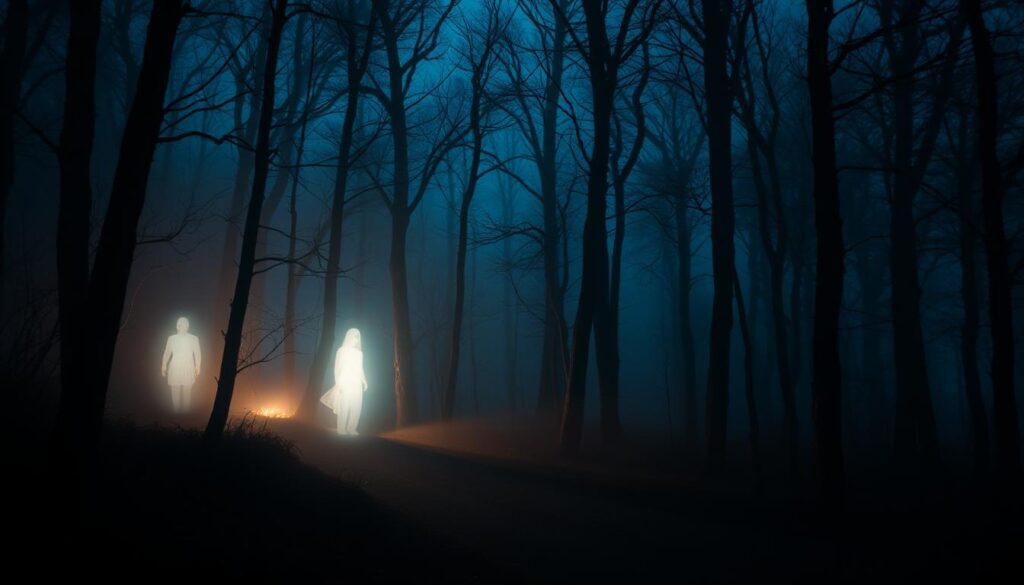
| Statistic | Value |
|---|---|
| Percentage of Americans who believe in ghosts | 46% |
| Individuals claiming to have seen a ghost | 18% |
| Episodes aired by “Ghost Hunters” | 230 |
| Proportion of Americans believing in the paranormal | 75% |
| People unsure about ghost encounters | Varies |
Haunted Locations Across America
America is a treasure trove of haunted locations, each with its own captivating stories that ignite your curiosity about the paranormal. Travelers and local enthusiasts alike flock to these ghostly hot spots, drawn by the rich tapestry of American ghost stories that unfold amid historic homes, battlefields, and even restaurants.
One of the most renowned sites is the RMS Queen Mary in Long Beach, California, where reports indicate that 49 individuals lost their lives during its operational years. This ship has become synonymous with chilling encounters and unexplained phenomena, making it a prominent destination for those seeking the supernatural.
Another striking example is the Hill House in Mineral Wells, Texas. This 3,800 square foot Victorian mansion, rumored to have once sheltered Native Americans, is a significant piece of local history. Its corridors are said to hold secrets and stories of spirits that linger, captivating countless visitors.
The Myrtles Plantation in St. Francisville, Louisiana, built in 1796, is infamous for its ghostly residents. Spread across a sprawling 600-acre estate, this location is said to experience haunting manifestations that weave into the fabric of its storied past.
In California, the Moss Beach Distillery stands as a former speakeasy turned restaurant, housing the legendary Blue Lady ghost. Patrons recount eerie sightings, bringing a ghostly flair to their meals amid the stunning coastal views.
For history buffs, the Lizzie Borden House in Fall River, Massachusetts, offers an intriguing overnight stay where guests can delve into the infamous past that surrounds it. The stories of its haunted legacy continue to draw attention, providing visitors with a unique opportunity to engage with American ghost stories.
Travelers venturing to New Orleans can’t overlook Madame Delphine LaLaurie’s neoclassical home, notorious for its dark history. This site remains one of the most famous haunted houses in the U.S., captivating ghost hunters and casual visitors alike.
Each state boasts its own collection of haunted locations. The Stanley Hotel in Estes Park, Colorado, claims the title of the most haunted place in America, inspiring the iconic tale of “The Shining.” Similarly, California brims with sites like Alcatraz and the Winchester Mystery House, while Arizona features haunted venues such as the Copper Queen Hotel in Bisbee.
Adventure awaits anyone willing to explore these haunted locations across the United States. The stories entwined within these sites encourage you to step into the shadows and experience firsthand the ghostly hot spots that continue to weave their mystical tales into the fabric of American history.

New Harmony State Historic Site
At the New Harmony State Historic Site, visitors often hear fascinating tales that intertwine history with the supernatural. Among the most striking accounts involve the presence of spectral figures, particularly the well-known wispy white woman. Her presence adds a layer of intrigue to the historic site, where curious guests seek to uncover the reality behind the legends.
Stories of the Wispy White Woman
The stories surrounding the wispy white woman have circulated since the 19th century. Patrons have encountered ghostly apparitions moving about the historic buildings, creating a palpable atmosphere of suspense. Moonlit nights hold a special enchantment as visitors recount experiences of feeling unexpected pushes down the stairs or witnessing lights illuminate where no electricity is found. This eerie ambiance continues to attract admirers intrigued by New Harmony ghost stories.
Piano Music in an Empty Room
Among the eerie events, reports of unexplained piano music echoing through the Fauntleroy House remain particularly chilling. Patrons describe the eerie notes emanating from seemingly empty rooms, leading to bewilderment and curiosity about the spirits that may linger within. Each note adds to the rich tapestry of New Harmony’s haunted history, compelling visitors to explore every shadow and sound.

Corydon Capitol State Historic Site
The Corydon Capitol State Historic Site stands out for its rich history and intriguing stories of paranormal activity. Tales of the legendary lady in red stir excitement among visitors and locals alike. Those exploring this site often report eerie encounters, including unexplained noises that echo through the halls.
Encounters with the Lady in Red
Among the most captivating stories is that of the lady in red. A volunteer’s daughter once described seeing her standing gracefully at the top of the stairs. This mysterious figure has left an imprint on the minds of those who visit. A group of Boy Scouts shared their experience of seeing the lady in red appear to soar past them near the kitchen stairs. Such sightings contribute significantly to the Corydon Capitol hauntings, drawing thrill-seekers and paranormal enthusiasts.
The Mystery of Phantom Footsteps
Thousands of visitors have traversed the historic site, and many have reported hearing phantom footsteps resonating in empty areas of the building. These unexplained noises add to the site’s haunted reputation. Staff members continuously recount experiences that fuel conversations about the supernatural. Perhaps the most compelling aspect of this site is the combination of these ghostly encounters, allowing you to immerse yourself in a world where history and the supernatural intertwine.

Exploring the Culbertson Mansion State Historic Site
The Culbertson Mansion State Historic Site stands as a testament to Indiana’s rich history and haunting tales. Visitors often report eerie encounters, adding to the mansion’s storied past. Experts have engaged in extensive paranormal documentation within its walls, leading to a collection of remarkable testimony regarding the Culbertson Mansion ghosts, particularly the spectral figure of Mary Ann Hopkins.
Documented Paranormal Events
Numerous accounts highlight unexplained phenomena that suggest a strong connection to the mansion’s occupants. Staff and first responders frequently recount experiences tied to the Mary Ann Hopkins haunting. These include sightings of her apparition along with instances where objects seem to move on their own. Such events have sparked the curiosity of historians and paranormal enthusiasts alike, pointing to the lingering spirit of this historical residence.
The Haunting of Mary Ann Hopkins
Mary Ann Hopkins, a pivotal figure in the mansion’s history, is often described in ghostly narratives. Eyewitnesses depict her as a gentle presence, frequently observed in the halls or near windows. The significance of her story is deepened by the emotional resonance it carries for those who encounter her spirit. Visitors frequently engage in discussions about her past, seeking to uncover more about the life she led and the purpose of her haunting at the Culbertson Mansion.

Indiana State Museum: A Modern Haunted Location
The Indiana State Museum stands as a beacon of history and culture in the heart of Indianapolis. Established as a contemporary facility, it surprises many with accounts of Indiana State Museum hauntings. Over the years, a noticeable number of visitors have reported various modern ghost encounters, which challenge the typical perceptions of hauntings being limited to older, more dilapidated sites.
Many guests have described eerie experiences, particularly during evening hours. Some recounted experiencing unexplained voices echoing through the halls, while others noticed unusual movements captured on security cameras. Such phenomena not only intrigue ghost hunters but also invite curiosity among casual visitors.
The museum has tailored specific tours focusing on its haunted reputation, allowing guests the chance to explore the intersection of history and the paranormal. Surveys show that a significant percentage of attendees visit in hopes of encountering the unexplained, fostering a unique atmosphere where both science and folklore can coexist.
As fascination grows, the types of paranormal activities reported continue to diversify, ranging from chilling phenomena to more benign encounters. The museum welcomes these stories, encouraging its visitors to delve deeper into both the past and the mysteries that still linger in its spaces.
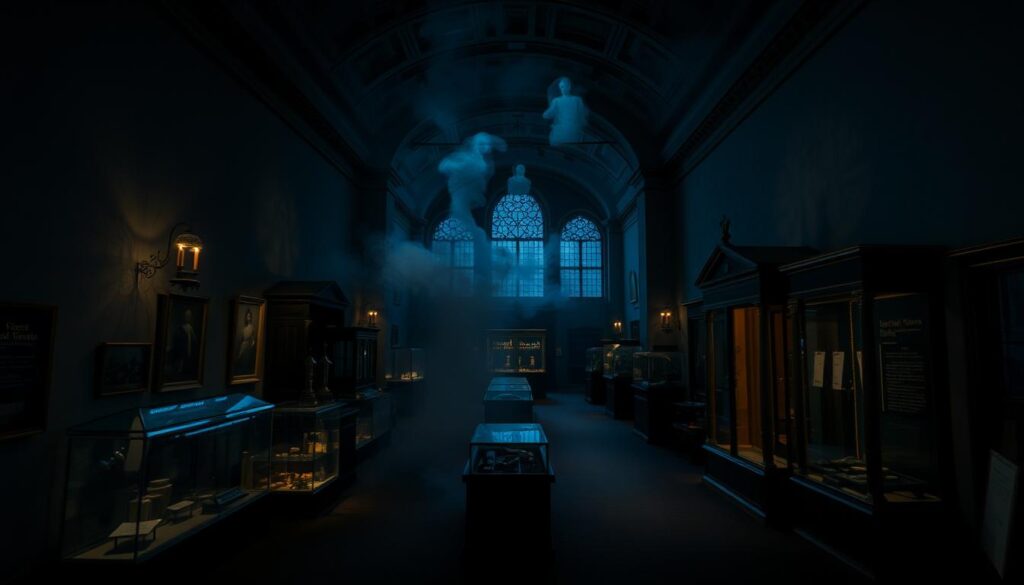
Real Ghostly Sightings from Across the U.S.
Across America, notable ghost sightings continue to stir fascination among enthusiasts and skeptics alike. Locations steeped in America’s haunted history provide a tapestry of ghost stories that reflect local cultures and beliefs. From the eerie halls of the Stanley Hotel in Colorado to the infamous Lizzie Borden House in Massachusetts, each site adds a unique chapter to the narrative of the supernatural.
The Stanley Hotel, known for its connection to Stephen King’s “The Shining,” has catered to guests for over a century. Its ghostly reputation was revitalized after the novel, drawing visitors eager to experience its haunted charm. Reports of unexplained phenomena and ghostly apparitions have become a part of its allure, captivating many who seek to uncover the truth behind these tales.
In San Diego, the Whaley House stands tall as “America’s most haunted house.” This historic site has garnered attention for its heavy footsteps, apparitions, and the lingering scent of cigars, attributed to its original owner, Thomas Whaley. This house serves not only as a landmark but also as a keeper of chilling ghost stories that echo within its walls.
Not to be forgotten, the Lizzie Borden House invites curiosity with its grim past. Visitors recount eerie laughter and objects mysteriously moving as they delve into the site of the notorious Borden murders. The emotional weight of such historical events adds depth to the ghost stories that critical thinkers and believers contemplate alike.
Below is a table summarizing ghost sightings across different notable locations:
| Location | Notable Sightings | Relevant History | Reported Experiences |
|---|---|---|---|
| The Stanley Hotel | Ghostly apparitions | Inspired Stephen King’s “The Shining” | Unexplained disturbances |
| Whaley House | Heavy footsteps, cigar smell | Known as America’s most haunted house | Interactions with Thomas Whaley’s spirit |
| Lizzie Borden House | Eerie laughter, moving objects | Site of the Borden murders in 1892 | Paranormal happenings reported by visitors |
These encounters highlight not only ghostly figures but also the emotion and history tied to them. Personal experiences at each location further emphasize the compassion, curiosity, and fears related to the supernatural. Such stories enhance the understanding of America’s haunted history, inviting more people to explore these famed locales and uncover the ghost stories that make them memorable.

Exploring Hilton Head’s Haunted Heritage
Hilton Head Island, with its stunning landscapes and rich history, serves as the backdrop for a myriad of ghostly tales. Among its most captivating stories are the eerie accounts from the Joseph Johnson House and the Stoney-Baynard Ruins. These locations are not just remnants of the past; they embody the spirits and legends that linger on the island.
Legend of the Joseph Johnson House
The Joseph Johnson House, often referred to as “The Castle,” is a focal point for Hilton Head ghost stories. It is steeped in intrigue, particularly with the Joseph Johnson House legend featuring the spirit of Gauche, a haunted dwarf jester believed to roam the halls. Visitors often share spine-chilling encounters, feeling an otherworldly presence as they explore the intricately adorned rooms. This connection to the past, dating back to French colonial times, encapsulates the essence of the ghosts that many claim have not moved on.
Paranormal Activity at Stoney-Baynard Ruins
The Stoney-Baynard Ruins offer another dimension of Hilton Head’s haunted heritage, where the remnants of a Civil War plantation home whisper stories of lost lives. This site is notorious for unexplained lights and phantasmal mists that envelop the area after dusk. Visitors experience the sensation of being watched, surrounded by the crumbling walls that once sheltered families. Many report witnessing the spectral apparitions of plantation owners, magical processions in the moonlight, and even ghostly soldiers in Civil War uniforms. The allure of Stoney-Baynard paranormal activity draws thrill-seekers eager to connect with the island’s haunted history.

The Role of Ghost Hunters in Documenting Encounters
The world of ghost hunting has gained immense popularity, captivating individuals drawn to the mysteries of the supernatural. Ghost hunters play a critical part in documenting sightings, utilizing an array of equipment, including voice recorders and thermal imaging cameras, to capture evidence of paranormal activity. This practice of paranormal investigation requires both skill and passion, as teams embark on explorations to unveil the unknown.
Statistics indicate a surge in interest during the late 2000s, largely fueled by ghost-hunting reality TV shows. For instance, The Atlantic Paranormal Society saw their membership double as excitement around ghost hunting grew. One group, A Midwest Haunting, reported an impressive increase in tour participation, from 600 in 2006 to 1,800 in 2008, demonstrating a clear public appetite for experiencing ghostly encounters firsthand.

Increased traffic on websites and message boards has been noted, reflecting the growing acceptance of ghost hunting as a viable interest. Jim Willis of Ghosts of Ohio highlighted that his group’s membership rose to 30, attracting both dedicated believers and skeptics alike. Amid this enthusiasm, countless small businesses have capitalized on the trend by offering ghost-hunting equipment and paranormal investigation services, resulting in significant revenue growth within this niche market.
While enthusiasts pursue captivating experiences, safety remains a paramount concern. Ghost hunters are advised to investigate haunted locations with groups to ensure a safer and more enjoyable experience. It is beneficial to gather comprehensive knowledge about a site’s history along with its past inhabitants, facilitating a more enriching investigation. Documenting sightings during ghost hunts, particularly through photography, provides an invaluable record of any encounters.
| Statistic | Detail |
|---|---|
| Membership Growth | The Atlantic Paranormal Society reported doubling their membership in the late 2000s. |
| Tour Participation | A Midwest Haunting’s tours increased from 600 to 1,800 participants between 2006 and 2008. |
| Group Dynamics | Ghosts of Ohio expanded to 30 members since its establishment in 1999. |
| Equipment Sales Growth | Small businesses selling ghost-hunting equipment experienced increases in the early 2000s. |
| Ghost Tours in Savannah | Over 31 ghost tours were reported in Savannah, Georgia, as of 2003. |
These perspectives illuminate the intersection of entertainment, safety, and curiosity within the realm of ghost hunting. As you delve into the world of paranormal investigation, recognize the balance between documenting sightings and maintaining diligence during your explorations.
Personal Experiences with Ghostly Sightings
Personal ghost experiences often stir deep curiosity and intrigue, sparking lively discussions among those who encounter spiritual phenomena. Many individuals report eerie events that challenge their understanding of reality. While some view these occurrences as anecdotal evidence, others express skepticism, seeking logical explanations for ghostly sightings.
Anecdotal Evidence vs. Scientific Skepticism
Ghost sighting skepticism thrives in a landscape filled with stunning claims and personal narratives. Research shows that 100% of individuals’ beliefs in ghosts began to waver following their own ghostly experiences. These stories are commonly shared in gatherings, like the paranormal conference that occurred in Gettysburg in 1999, where encounters led to various discussions among enthusiasts and skeptics alike.
A variety of eyewitness accounts span locations, including charming towns in Massachusetts. Many readers studied in areas like Leominster, Lexington, and Boston shared their personal ghost experiences, including sightings of faceless figures and ghostly ladies. Anecdotes ranged from objects mysteriously moving to spooky events, such as the hidden door that closed without any explanation.
Consider the ghostly sightings reported at Disneyland Resort. In August 2019, a young girl was seen in a locker area, captivating visitors. Experiences from former custodial workers also uncovered strange happenings in various locations. Encounters in basements, old colonial homes, and even retreat centers revealed a rich tapestry of interactions with the paranormal world.
Underpinning these stories lies the work of organizations like the Committee for Skeptical Inquiry, established in the 1970s. With over 20 years of experience, they evaluate firsthand accounts, historic sites, and police reports dating back to the 1800s. They strive to sift through the allure of personal ghost experiences for factual evidence to substantiate these claims.
| Location | Reported Experiences | Year of Encounter |
|---|---|---|
| Leominster, MA | Sightings of a ghost lady | Varied |
| Disneyland Resort | Sighting of a young girl | 2019 |
| Gettysburg | Encounters discussed at a conference | 1999 |
| Tiki Terrace | Voices and moving objects | Varied |
| Haunted Mansion, Disneyland | Elderly woman vanishing | 2002-2004 |

The Psychology Behind Ghostly Encounters
The fascination with ghostly encounters often stems from a range of psychological explanations that help illuminate the perception of ghosts. Studies reveal that about 18 percent of Americans report experiencing such phenomena. Interestingly, approximately 75 percent of the population holds at least one paranormal belief, showcasing a widespread inclination towards these extraordinary perspectives. Among these beliefs, women tend to endorse paranormal ideas more than men, who typically lean towards beliefs in aliens or unknown life forms.
Cognitive biases play a significant role as well. Individuals with intuitive cognitive styles often report a higher propensity to accept paranormal beliefs compared to those who adopt more analytical approaches. Factors such as high openness to experience, extraversion, sensation-seeking tendencies, and low industriousness correlate with a stronger belief in the paranormal. Moreover, those who are intolerant of ambiguity may find themselves more susceptible to experiencing eerie sensations or “seeing” ghosts.
Diving deeper, the data shows that individuals who describe themselves as believers yet do not attend religious services regularly are twice as likely to believe in ghosts compared to those who are firm nonbelievers or highly devoted in their faith. This intriguing dynamic suggests that personal belief systems may influence their perception of ghosts.
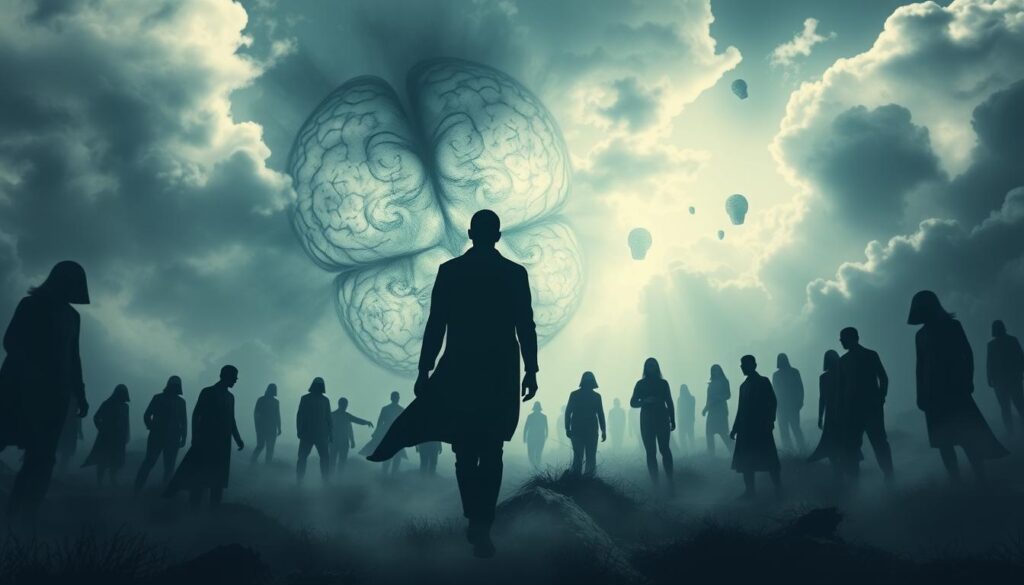
Research surrounding hallucinations presents another compelling angle. Approximately 50 percent of individuals dealing with Parkinson’s disease experience hallucinations that can manifest as ghostly figures, indicating a complex relationship between brain chemistry and ghost sightings. The concept of Haunted People Syndrome (HP-S) adds another layer, suggesting that family dynamics and psychological factors may significantly contribute to reported paranormal experiences.
In conclusion, understanding the psychological explanations behind ghostly encounters opens a window to exploring how environmental factors, sociocultural influences, and cognitive biases shape our views on the supernatural and the ghostly. Insights into our minds can provide clarity on the seemingly mystical experiences that some people claim to encounter.
Conclusion
In summary of ghostly sightings, your exploration of these fascinating encounters reveals a rich tapestry of human beliefs, historical perspectives, and psychological frameworks. From the narratives woven throughout time to the compelling theories like place-memory and the Stone Tape theory, these stories not only entertain but also stimulate your mind to reflect on the deeper mysteries of existence. It’s intriguing to consider how these sightings and experiences may bridge the gap between the known and the unknown.
As you delve into the reflection on paranormal encounters, it becomes apparent that many people share similar experiences, with a significant percentage of Americans believing in ghostly presences. This phenomenon often transcends mere superstition, suggesting a collective curiosity about what awaits beyond the grave. Whether through personal anecdotes or scientific studies, your interaction with these tales can enrich your understanding of human culture and the search for meaning in life.
Ultimately, engaging with ghostly encounters prompts you to ponder not just the stories themselves, but the psychological mechanisms at play when we confront the unexplained. Whether drawn to these narratives as a source of entertainment or as a means to explore the complexities of memory and existence, your journey into the world of the paranormal offers a unique opportunity for introspection and discovery.


